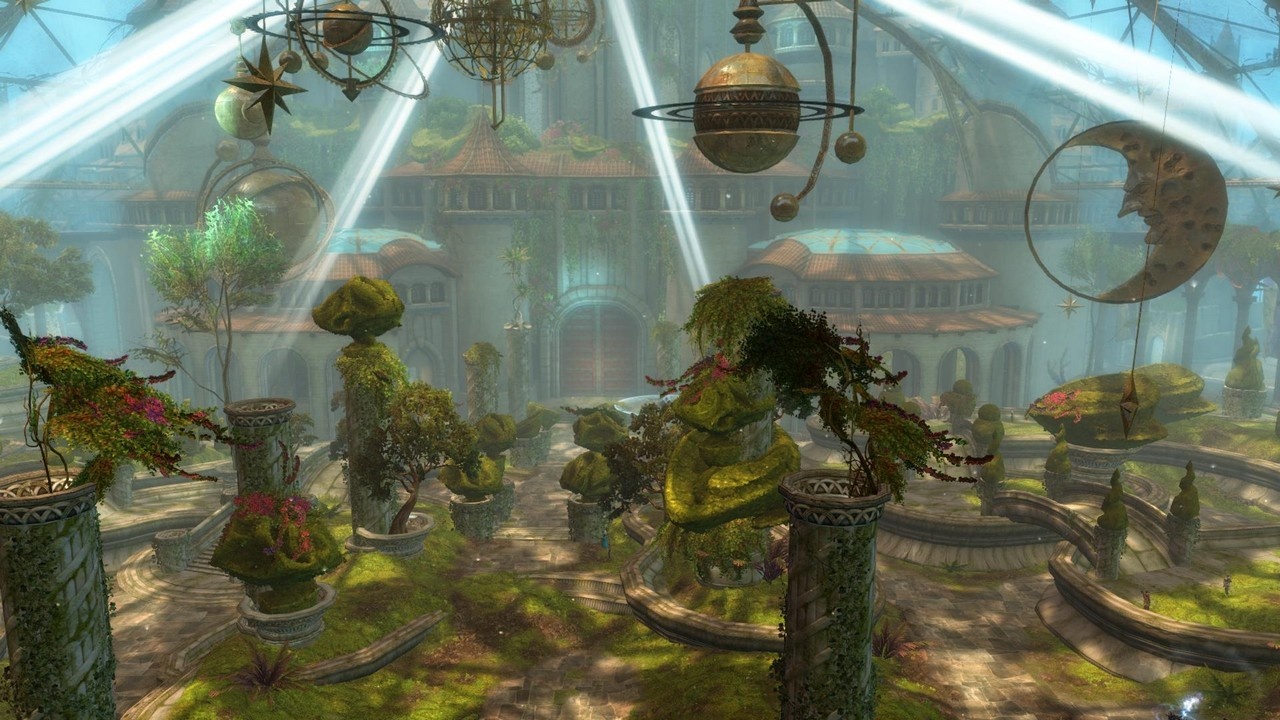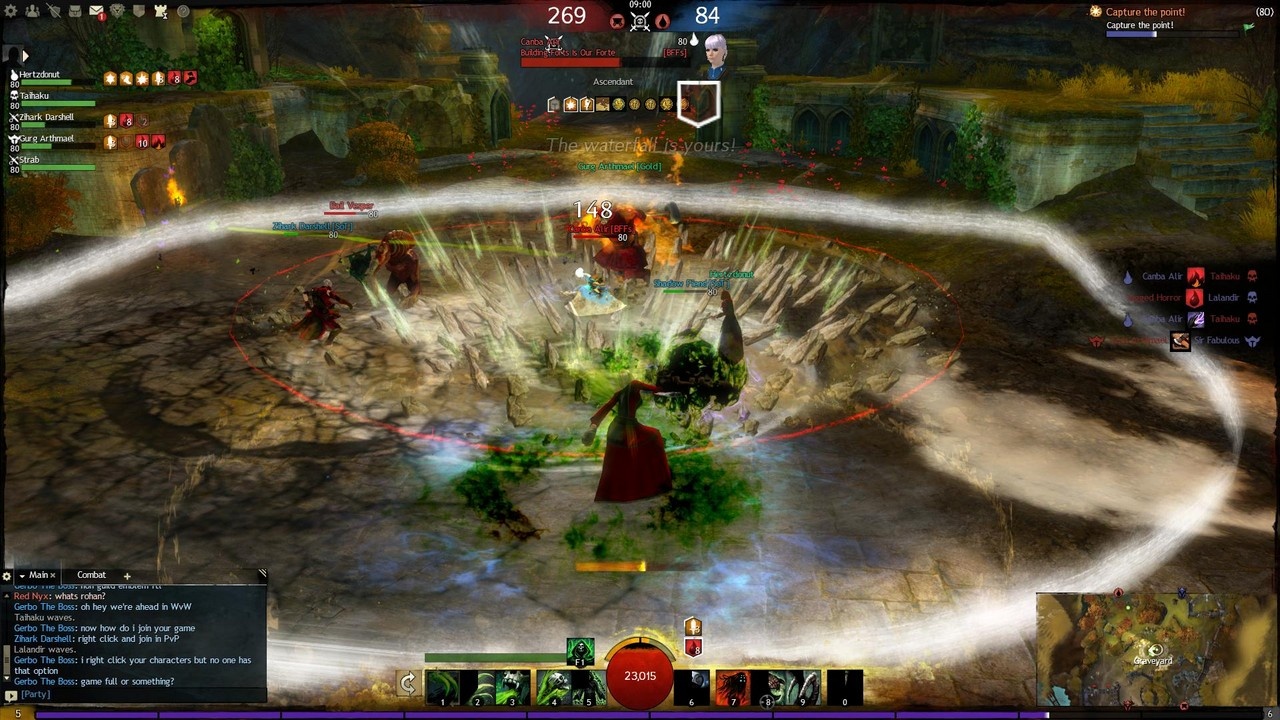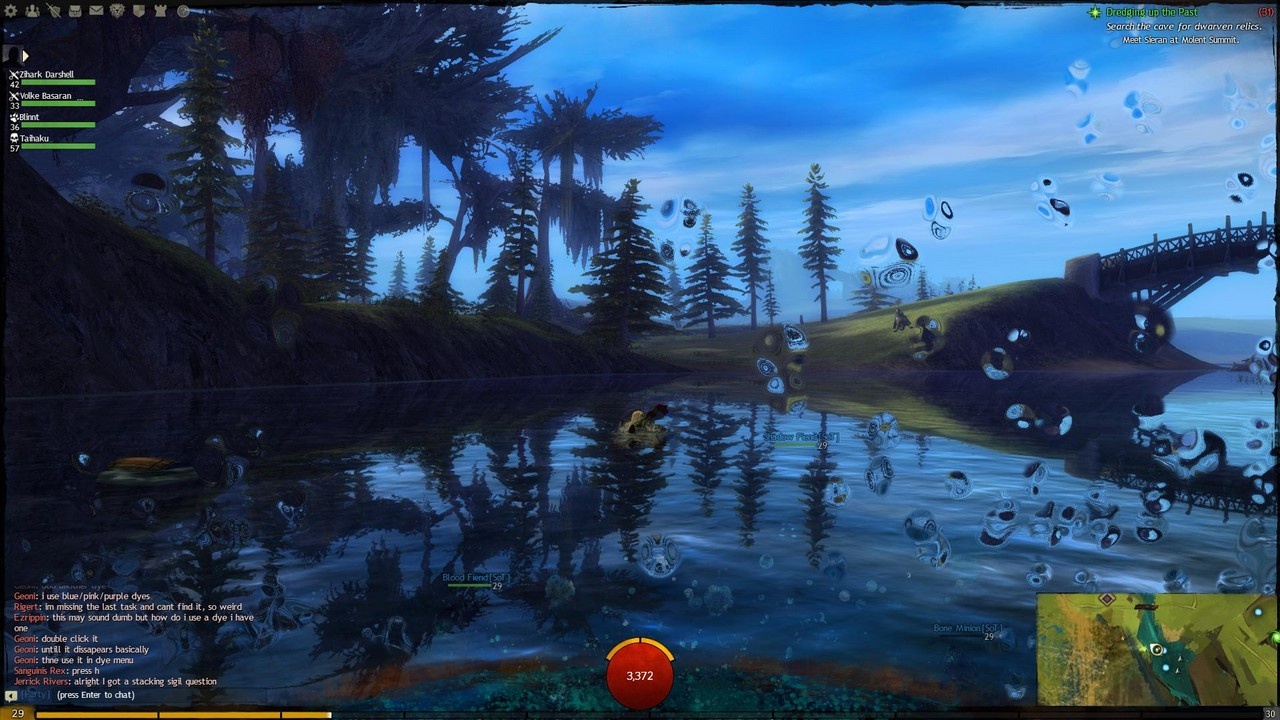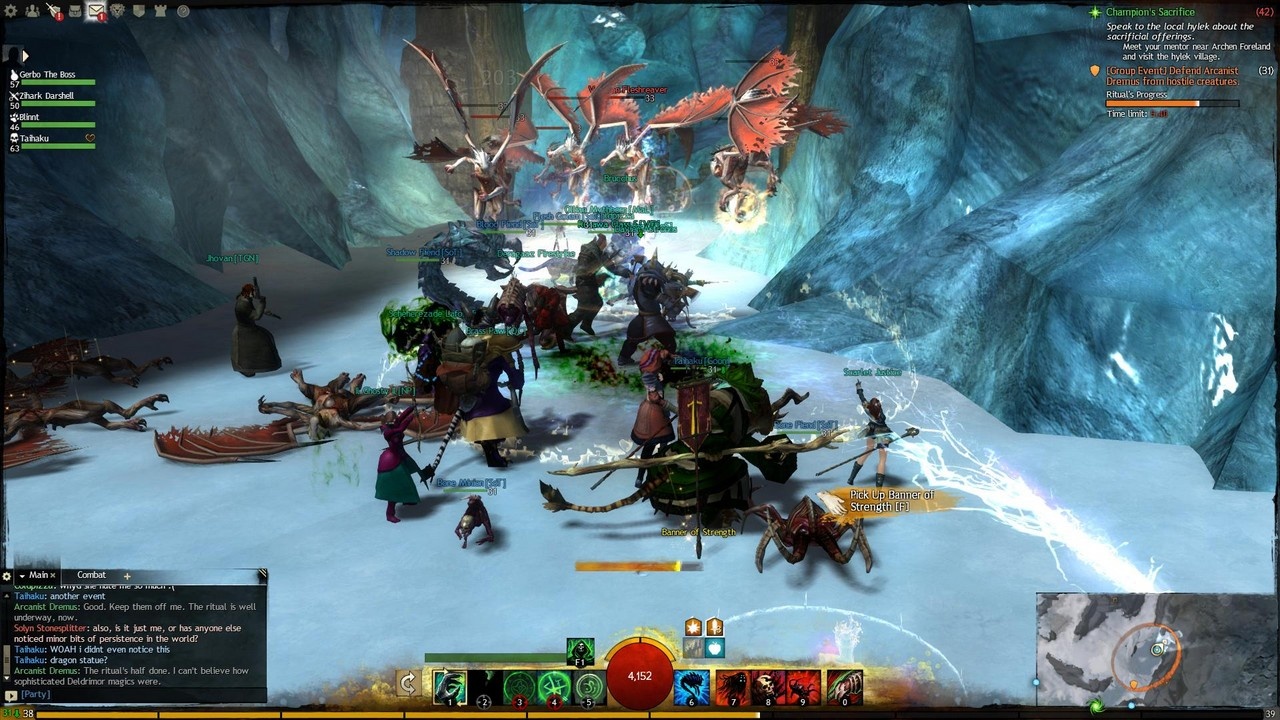The world of Tyria, as imagined in the massively multiplayer Guild Wars 2, is an endlessly intriguing place, stuffed with mystery and adventure, gifting you with gorgeous sights and personal stories that etch themselves into your memory. These are the kinds of stories you tell for months to come--and they arise from your own spontaneous experiences. There's the one about how you and your guildmates emerged from chilly waters into an ominous thunderstorm, captured a tower from the enemy, and escaped from a roaring crowd of necromancers and rangers before they could deliver you to the devil. Then there's the one where a giant lightning-breathing dragon landed in a dark-misted field, and you joined a legion of soldiers to cleanse the land of its blight. Guild Wars 2 strips away the traditional game of "follow the waypoint," allowing you to feel like part of a vast living landscape rather than the tool of a thousand and one taskmasters.
How does Guild Wars 2 make Tyria so inviting and inventive? It starts with the loss of the traditional quest log. That isn't to say that Guild Wars 2 doesn't provide you with side quests and other activities outside your main storyline--it's that they are structured in a way that makes them organic to the world around you. In a sense, your map serves as a journal. Here, you see points of interest to discover; waypoints that you can unlock and that serve as nodes for quickly traveling from one area to the other; and non-player characters designated with hearts that have optional activities for you to do.
Your map is more than a sketch of the surrounding lands: it's a personal guide to your adventure, beckoning you to uncover unexplored territory. It isn't just the marked activities that have you peeking into every nook, however, but the surprises lurking on mountaintops and within hidden caves. Suddenly, you're stumbling upon a secretive entrance or emerging from a deep lake to discover a hidden oasis. Further inspection reveals hidden treasure, tricky labyrinths, and giant ogres needing a smackdown.
As for the more structured activities, those NPCs labeled with hearts are more than just quest givers--they're vendors, too. By fulfilling these characters' requests, you get access to whatever gear they sell, which you buy not with gold, but with a currency called karma, earned by participating in world events (more on those soon) and by just doing things. This system of hearts is more or less like the traditional "take quest, earn reward" structure of most role-playing games, but the reward is access to a merchant's entire inventory, rather than a piece of equipment you may not want or need. You don't have to speak to that character to take on the task--you just get prompted when you come near, and the prompt disappears if you leave the area before completing the goal. (Of course, it then reappears when you again enter the area.)
These might seem like small adjustments to a familiar formula, but Guild Wars 2 rethinks old standards in new ways so that you can go have an adventure of your own, rather than be guided through one someone else created for you. For instance, like in other massively multiplayer online games, you can visit low-level areas as a high-level character--perhaps the starting regions of other races--for a change of scenery. But in other games, there's no real reason to be there: the quests don't provide pertinent rewards, and local wildlife goes down in a single hit. In Guild Wars 2, your level scales downward in such places so that your foes are a greater threat. Furthermore, while your experience rewards aren't notable in lower-level regions, the loot you earn is scaled to match your level, as opposed to the region's. And by rethinking a single trope, developer ArenaNet makes each glade, swamp, and valley a tantalizing destination for every player.
Those "heart" missions generally have you performing any number of tasks: repairing fences, killing enemies, delivering ale to thirsty inn patrons, and more. Not every task is all that engaging; some activities are just busywork (collecting tools), while others involve elements (such as stealth) that don't feel natural given Guild Wars 2's basic mechanics. But you're always free to move on to something more interesting, perhaps to discover another grand vista. Vista points are scattered about Tyria and seen as glowing bits of parchment, usually hovering in spots just out of reach.

Getting to those vistas can be a joy or a chore (usually the former), depending on the quality of the jumping puzzles that lead to them. Leaping about in Guild Wars 2 isn't a slog--the game has perhaps the most fluid movement in the genre--but the camera has a tendency to get caught up on walls and ceilings. When you're afforded the opportunity to see all around you, scaling icy cliffs and rickety planks is a pleasure. In cramped environments, the camera might freak out, and you can't see well enough to make an educated leap. But even when you wrestle with the camera, the effort is worthwhile: you activate the vista, and the camera spins about, showing off the spectacular panorama surrounding you. A gentle tune accompanies the moment, and you revel in the pastoral uplift it creates.
While you do get experience for unlocking these vistas, the greater reward is getting the chance to admire Tyria without hindrance. Guild Wars 2 is a beautiful game that makes an impression in big ways and small. In Lion's Arch, a bridge takes the form of a giant sloop now retired from its days sailing the seas. In Blazeridge Steppes, a dragon's electric attacks have burned the foliage to a crisp; swirling claw marks and a shimmering veil of darkness tell tales of the devastation that occurred there. From snowy mountains to humid swamps, Tyria encompasses a diverse number of climates and landscapes, yet it still looks remarkably cohesive.
The cohesion comes from painterly techniques employed in textures, special effects, and even the interface. Look at the edges of spell effects and the trails of projectiles, and you see swirls that recall a painter's brushstrokes. The sides of the screen are embellished with subtle inky streaks, as if your entire view were being drawn in real time. Such techniques are most effective in lush meadows and forests: strips of green, gold, and mahogany make tree trunks seem as though they belong on a canvas, and forest canopies look like layers of acrylic due to subtle gradations of light and color. These touches aren't heavy-handed, but make Tyria more than just another fantasy world.
The 3D-as-2D approach is most obvious during cutscenes in which one or two 3D characters are superimposed upon a moving 2D background. These cinematics are attractive, if not particularly dramatic; the minimal staging doesn't effectively demonstrate emotion, nor does much of the acting from the Norn and human races. (The female Norn player character is excruciatingly inexpressive.) Atmospheric dialogue is more impressive, and some of it will tickle your funny bone. While the voice acting varies from poor to great, you can always count on the symphonic musical score to set an exact tone for every region and event. In a tranquil grove, a flute and oboe weave melodic threads in and out of each other--simple music for simple surroundings. Heavy drums and pungent trombone licks immediately evoke the ferocity of the Charr. It's a terrific soundtrack that stands on its own, but more importantly, it suits the world at large, its people, and its individual places.
Just as the visuals and music contrast the peaceful with the powerful, so too does your adventure. You might be leisurely crossing a lovely meadow, only to be alerted to a nearby world event. The event might then lead to another, ultimately culminating in a giant boss encounter or furious area-wide struggle for dominance. The fight may start small: a crowd of centaurs, easily defeated by the group of players the event has brought together. Soon, champion warbeasts have arrived, their sharp scales forcing you to work harder for victory. And then, a giant hand reaches from under the earth, as if a trapped golem is escaping from its underground prison. This ravaging battle isn't one you are expected to fight, but one you stumble upon as you roam the land. And that's the Guild Wars 2 experience: going about your business, only to be drawn into another battle, another hidden secret, or another bit of Tyrian lore.

Guild Wars 2's reimagining of so many role-playing standards has a downside: the game does a mediocre job of introducing you to its new way of thinking. Generic tips appear in your hints menu, but these aren't adequate teaching tools; playing Guild Wars 2 successfully means shedding preconceived notions and learning a new approach. But there's a lot to take in, and even after you switch gears, you still stumble upon information by accident, or are educated by other players. How do I unlock more traits? Which merchants sell gathering supplies? What crafting professions best complement my class? Simple information like this isn't as quick to come by as you might think, and visual cues and map markers either don't give a lot of information or aren't obvious about it.
This touch of obtuseness is notable in part because most aspects of Guild Wars 2 are designed to keep you playing instead of wasting time on typical MMOG padding. Need to free up some inventory and deposit crafting supplies in the bank? Do it right from your inventory screen. Want to travel across the entire continent? Forget mounts: just click on an unlocked waypoint and teleport there--for a nominal fee, of course. Want to access the trading post (that is, the player auction house)? Bring it up with the press of a key. (You need to visit a trade broker to pick up your supplies, however.)
Another great convenience: all races can be any class, so you needn't choose between an appealing character and an appealing set of skills. You'll come to appreciate that Guild Wars 2 values your time, and wonder why more games haven't implemented such features. Of course, you may also appreciate the lack of a monthly fee. You can buy certain conveniences from a real-money store--more inventory space, armor dyes, and whatnot--but you couldn't reasonably call Guild Wars 2 "pay to win."

Guild Wars 2's exploration value and creative restructuring of old concepts deserve praise--but so, too, does the moment-to-moment gameplay. Combat and movement feel exceptionally fluid and responsive, and much of this has to do with the way skills are implemented. Superficially, Guild Wars 2's combat system resembles that of other MMOGs, in the sense that you have a bar of skill icons at the bottom of the screen, and you perform attacks by pressing the hotkeys associated with them. But there's a deeper and more malleable system here than initially meets the eye, and once it's fully in play, you are consistently engaged with the action; you rarely just hit the auto-attack key and let the game do the work.
Notably, you have only 10 main skill slots--five to the left of your health orb, and five to the right. The ones on the left are associated with your equipped weapon. In the case of a two-handed weapon, all five slots are associated with that weapon; otherwise, they might be split between a primary weapon and a supplementary one. But you also have two sets of weapons at any given time, and can switch between them--and in doing so, access a completely different set of attacks. You even have different sets of weapons and skills when delving underwater, and automatically switch to them when submerged. Skill cooldown rates are quick, and being a successful player means frequently changing sets in combat. And that, in turn, means staying consistently busy during the battle.
Class skills are another consideration, both outside combat and within it. You can have only five class skills active at a time, but while that might sound limiting, there's a good deal of flexibility here. You earn skill points fast enough (and you can earn more by completing skill challenges found on the map) that you soon unlock more abilities than you can ever equip at once. You can stick to a play style that works for you--bringing along a legion of pets to do some of your dirty work, for instance--but your favorite combination won't be ideal in all situations, so you might be pressed to try something new. And even with just those five skills in play, you can exercise more control than the number "five" would communicate. Rangers and necromancers have special pet skills to use once their minions are summoned, elementalists can attune themselves to different elements, and engineers have various healing and utility skills to manage.

With this flexible class system, Guild Wars 2 jettisons typical MMOG roles (healer, tank, and so on). This works out better in the game's enjoyable five-man dungeons than you would think, for a few reasons. First of all, every class has some kind of healing skill, so while no one player is dedicated to keeping teammates alive, everyone can contribute to the party's general health. You can revive a fallen player, too--and should you fall, you can even make a last-ditch effort to rejoin the fight. Furthermore, Guild Wars 2 allows you to use environmental objects and weapons, from rocks to ballistae, so if you need to knock down a pesky spellcaster and no one has a helpful skill, just grab a stone and throw it.
Not having obvious combat roles doesn't mean that some battles don't require strategy. In one dungeon, for example, a particularly nasty boss spawns swarms of spiders, and your team needs a battle plan lest they succumb to a mess of skittering legs and clouds of poison. In the main world, on the other hand, many battles are just a vast crowd slashing away at a big bad meanie, spells flying everywhere to the point where you can't see what's going on, and you're not even sure if you're contributing to the chaos. Yet even in such instances, excitement levels are through the roof, particularly when that big bad meanie is a fearsome purple dragon with a wingspan of an entire valley.

Other players make for more stubborn enemies than even big dragons, and Guild Wars 2's player-versus-player battlefields are great, particularly the world-versus-world realm. In these persistent warzones, players from three servers vie for dominance by capturing keeps, purchasing and employing siege equipment, and overcoming the enemy with brute force and smart tactics. You might join a roving band of heroes and encounter a seemingly unstoppable wall of other players, none of them identified by name--only by guild tag. Such moments are beautiful, terrifying madness, players trying to gain high ground and manage a battlefield swarming with dozens if not hundreds of combatants. But there's also room to lead a surgical strike team, avoiding the keen eye of your foes and yanking away control of a tower left unguarded.
Such battles instill a sense of triumph when you succeed, and heartbreak when you fail. Defending a keep from the walls above, only to abandon it when it's overrun--or to die trying to save it--is deflating. It takes a special game to make you feel disappointment like that deep in your gut, and Guild Wars 2 generates the right sort of emotional investment. There in the world-versus-world, it does so in some of the same ways it does in Tyria proper: with vistas to discover and world events that call you to action.
There's also a unique interplay between the WVW and the core adventuring that drives you to battle. While you are bumped up to the maximum level of 80 when facing other servers, you still take only the skills you've earned up to that point, which drives you to explore the player-versus-environment content and learn skills. Meanwhile, story quests and world events sometimes mirror the mechanics of WVW battles, making these aspects of the game feel like two sides of the same coin rather than wholly disparate features.
You can also face other players in one-off battles, in which case not only are you bumped up to level 80, but you gain access to all available class skills as well. Such battles don't contribute to your overall experience; instead, there is a ranking system specific to player-versus-player, and weapons and rewards are separate from the rest of the game. Even without persistence, however, these battles are exciting tests of skill and are fun playgrounds for various character builds. Stories are made here, just as they are elsewhere. You'll tell others of the time you fought for control of a capture point and triumphed, pushing the team over the hump to a sliver-thin 500-499 victory. Or maybe you'll tell the tale of how a school of sharks mauled an overly aggressive Mesmer as you swam back and flung dark magic toward his tiny Asuran torso.
One concern you might have is whether the game is stable, and while the answer is a solid "yes," there have been some issues during the launch phase, such as trading post problems, glitched world events, scripted moments that can get you stuck in a monster's geometry, and a few other oddities. But these aren't defining moments, and many have been cleaned up hastily, allowing the incredible exploration and thrilling player-versus-player combat to command attention. There's so much more that could be said about Guild Wars 2--the branching story paths, the keg brawl minigame, crafting at the mystic forge--and that says a lot about the breadth and depth of this online world. Tyria isn't just a place you should visit; it's the place you should call your new online home.

